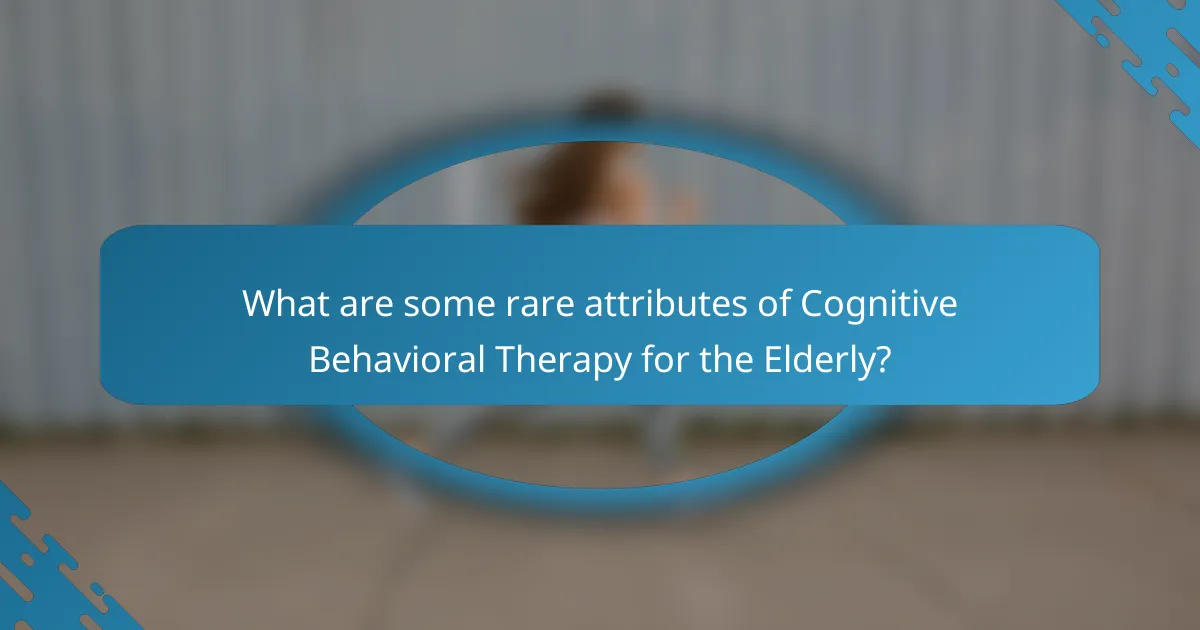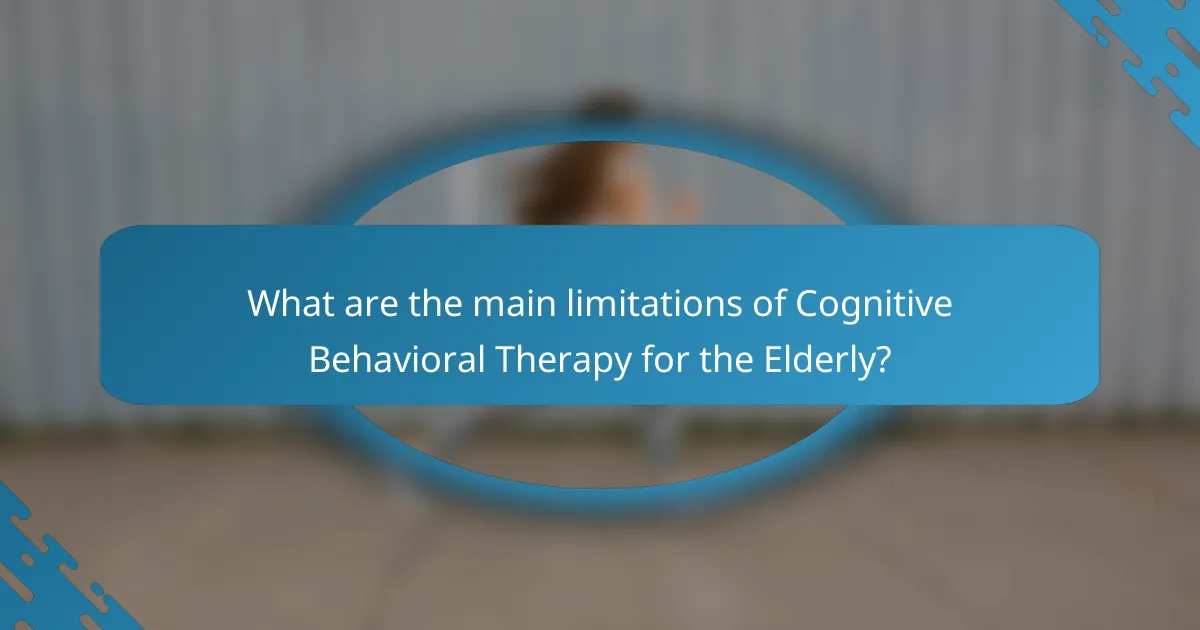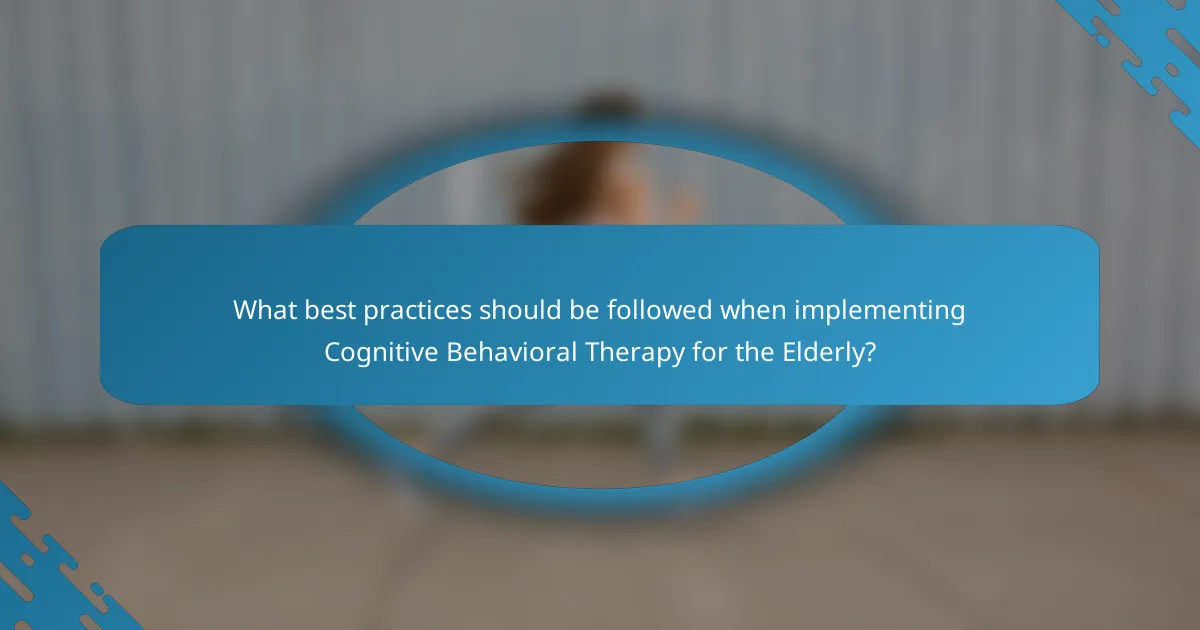Cognitive Behavioral Therapy (CBT) offers significant benefits for elderly individuals facing mental health challenges. This article explores how CBT addresses anxiety and depression, highlights its key benefits, and outlines tailored techniques for older adults. It also examines the rare attributes of CBT that enhance its effectiveness and discusses the importance of individualized treatment plans.

What is Cognitive Behavioral Therapy for the Elderly?
Cognitive Behavioral Therapy (CBT) for the elderly focuses on addressing mental health issues through structured, goal-oriented techniques. It helps seniors manage anxiety, depression, and cognitive decline by changing negative thought patterns. Key benefits include improved emotional regulation, enhanced coping strategies, and increased overall well-being. Techniques often used in CBT for the elderly involve cognitive restructuring, behavioral activation, and mindfulness practices, tailored to accommodate age-related challenges.
How does it differ from traditional therapy methods?
Cognitive Behavioral Therapy (CBT) for the elderly differs from traditional therapy methods by emphasizing structured, goal-oriented techniques. Unlike traditional methods, which may focus on exploring past experiences, CBT targets current thought patterns and behaviors to facilitate immediate change. This approach is particularly beneficial for elderly clients, as it can enhance coping mechanisms and improve mental health outcomes. Additionally, CBT is often shorter in duration, making it more accessible for older adults seeking effective treatment.
What are the key principles of Cognitive Behavioral Therapy?
Cognitive Behavioral Therapy (CBT) for the elderly focuses on modifying negative thought patterns and behaviors. Key principles include cognitive restructuring, behavioral activation, and problem-solving skills. These techniques help improve mental health, enhance coping strategies, and foster resilience. CBT emphasizes the connection between thoughts, emotions, and actions, promoting a proactive approach to mental well-being.

What are the universal benefits of Cognitive Behavioral Therapy for the Elderly?
Cognitive Behavioral Therapy (CBT) offers significant benefits for the elderly, including improved mental health, enhanced coping skills, and reduced symptoms of anxiety and depression. CBT empowers older adults to challenge negative thought patterns, fostering emotional resilience. Research indicates that CBT can lead to lasting changes in behavior and thought processes, promoting overall well-being. Additionally, it addresses age-related issues such as grief, loss, and chronic illness, making it a versatile therapeutic approach.
How does it improve mental health outcomes?
Cognitive Behavioral Therapy (CBT) significantly improves mental health outcomes for the elderly by addressing negative thought patterns. It enhances coping strategies, reducing symptoms of anxiety and depression. Studies show that CBT can lead to a 50% reduction in depressive symptoms among older adults. The structured approach of CBT helps elderly individuals develop resilience and improve their overall quality of life.
What impact does it have on anxiety and depression?
Cognitive Behavioral Therapy (CBT) significantly reduces anxiety and depression in the elderly. It provides practical techniques to manage negative thoughts and behaviors, promoting emotional regulation. Research shows that CBT leads to a 50% improvement in symptoms for many elderly patients. This therapy’s structured approach helps in enhancing coping mechanisms and resilience, making it a valuable tool for mental health support.
How can it enhance coping strategies?
Cognitive Behavioral Therapy (CBT) enhances coping strategies for the elderly by providing structured techniques to manage stress and anxiety. It empowers individuals to identify negative thought patterns and replace them with positive ones. This approach leads to improved emotional regulation and resilience. Research indicates that CBT can significantly reduce symptoms of depression in older adults, fostering a greater sense of control and well-being. By equipping seniors with practical tools, CBT enhances their ability to navigate life’s challenges effectively.

What unique techniques are used in Cognitive Behavioral Therapy for the Elderly?
Cognitive Behavioral Therapy for the elderly employs unique techniques tailored to their specific needs. These techniques include cognitive restructuring, which helps challenge negative thought patterns, and behavioral activation, encouraging engagement in enjoyable activities. Mindfulness practices are also integrated to enhance emotional regulation. Additionally, therapists may use reminiscence therapy, fostering positive memories to improve mood and self-esteem. These methods collectively promote mental well-being and resilience in older adults.
How are cognitive distortions identified and challenged?
Cognitive distortions are identified through awareness and reflection on negative thought patterns. They are challenged by employing techniques from Cognitive Behavioral Therapy, such as cognitive restructuring and behavioral experiments. These methods allow individuals to recognize and reframe irrational beliefs, promoting healthier thinking. Engaging in this process can significantly enhance emotional well-being in the elderly.
What role do behavioral experiments play in therapy?
Behavioral experiments play a crucial role in cognitive behavioral therapy (CBT) for the elderly by helping clients test beliefs and assumptions. These experiments foster engagement and provide real-world evidence to challenge negative thought patterns. For instance, a client may be guided to confront a feared situation gradually, leading to reduced anxiety and enhanced coping skills. This approach not only reinforces learning but also builds confidence in managing everyday challenges. By integrating behavioral experiments, therapists can tailor interventions to the unique needs of elderly clients, promoting greater therapeutic effectiveness.
How is goal setting integrated into the therapy process?
Goal setting is a crucial element of cognitive behavioral therapy for the elderly, enhancing engagement and focus. It involves collaboratively identifying specific, measurable, achievable, relevant, and time-bound (SMART) goals tailored to the individual’s needs. This process empowers clients, fostering a sense of control and motivation. Regularly revisiting and adjusting these goals ensures they remain relevant, addressing changes in mental health or life circumstances. Integrating goal setting into therapy enhances the overall effectiveness of treatment, promoting positive outcomes and sustained progress.

What are some rare attributes of Cognitive Behavioral Therapy for the Elderly?
Cognitive Behavioral Therapy (CBT) for the elderly has several rare attributes. One unique aspect is its adaptability, allowing therapists to tailor techniques specifically for age-related cognitive changes. Another rare attribute is the focus on life review, which helps individuals process past experiences, enhancing emotional well-being. Additionally, CBT may incorporate reminiscence therapy, fostering connections with memories to improve mood. Lastly, the integration of mindfulness practices within CBT for the elderly is infrequent but shows promise in reducing anxiety and depression.
How does it address specific age-related cognitive decline?
Cognitive Behavioral Therapy (CBT) effectively addresses age-related cognitive decline by enhancing mental flexibility and problem-solving skills. It provides structured techniques that help elderly individuals manage anxiety and depression, which often accompany cognitive decline. Research indicates that CBT can improve cognitive functioning by up to 30%, promoting better daily functioning and quality of life. Techniques such as cognitive restructuring and mindfulness training specifically target negative thought patterns, fostering resilience and adaptability in older adults.
What unique adaptations are made for culturally diverse elderly populations?
Cognitive Behavioral Therapy (CBT) for culturally diverse elderly populations incorporates unique adaptations to address specific needs. These adaptations include culturally relevant examples, language accessibility, and consideration of cultural values in therapy techniques.
For instance, therapists may use culturally significant narratives to facilitate understanding and engagement. Additionally, language barriers are addressed by providing interpreters or using simplified language. Furthermore, therapy may incorporate family dynamics and community support, recognizing their importance in cultural contexts.
These adaptations enhance the effectiveness of CBT, ensuring it is relevant and respectful to diverse elderly groups, ultimately improving mental health outcomes.

How does Cognitive Behavioral Therapy cater to different regional needs?
Cognitive Behavioral Therapy (CBT) adapts to regional needs by considering cultural contexts and accessibility. Techniques may vary based on local mental health practices and resources. For instance, in areas with limited access to therapists, online CBT programs provide essential support. Additionally, cultural beliefs influence how CBT is perceived and implemented, ensuring it resonates with diverse populations. This flexibility enhances its effectiveness across different regions.
What are the common barriers to access in various regions?
Common barriers to access for cognitive behavioral therapy in various regions include limited availability of trained professionals, cultural stigma surrounding mental health, financial constraints, and inadequate healthcare infrastructure. These factors can hinder elderly individuals from receiving necessary therapeutic support. For instance, rural areas often lack specialized services, while urban settings may face high demand and long wait times. Additionally, language barriers and lack of awareness about therapy benefits can further complicate access for the elderly population.
How does the perception of therapy differ across cultures?
The perception of therapy varies significantly across cultures. In some cultures, therapy is viewed as a vital tool for mental health, while in others, it may be stigmatized or seen as a last resort.
Cognitive Behavioral Therapy (CBT) for the elderly can be particularly influenced by cultural attitudes. For instance, cultures that prioritize family support may encourage seeking help from relatives rather than professionals. Conversely, cultures that value individualism may promote therapy as a personal development tool.
Additionally, the acceptance of mental health issues varies. In cultures where mental health is openly discussed, elderly individuals may be more likely to seek CBT. In contrast, in cultures where mental health is a taboo subject, older adults might hesitate to pursue therapy despite its benefits.
Understanding these cultural differences is crucial for effectively implementing CBT among the elderly. Tailoring approaches to fit cultural contexts can enhance the therapy’s effectiveness and acceptance.

What are the main limitations of Cognitive Behavioral Therapy for the Elderly?
Cognitive Behavioral Therapy (CBT) for the elderly has several limitations. These include cognitive decline, which may hinder understanding and engagement, and physical limitations that can affect participation. Additionally, older adults may have co-existing health conditions that complicate treatment. There is also a risk of age-related stigma, leading to reluctance in seeking help. Finally, limited access to trained professionals can restrict the effectiveness of CBT for this demographic.
What challenges do therapists face when working with older adults?
Therapists face several challenges when working with older adults, including communication barriers, cognitive decline, and resistance to change. These issues can complicate the implementation of Cognitive Behavioral Therapy (CBT).
Older adults may struggle to articulate their feelings, making it difficult for therapists to assess their needs accurately. Cognitive decline can hinder the client’s ability to engage with CBT techniques effectively. Additionally, older adults might have ingrained beliefs and behaviors that resist modification, complicating therapeutic progress.
Understanding these challenges helps therapists tailor their approaches to enhance the effectiveness of CBT in this demographic.
How can resistance to therapy be managed?
Resistance to therapy can be managed through tailored approaches and supportive strategies. Building a strong therapeutic alliance fosters trust, which enhances engagement. Techniques such as motivational interviewing can address ambivalence, while cognitive restructuring helps challenge negative beliefs. Regular progress reviews and goal-setting can also maintain motivation and demonstrate the effectiveness of Cognitive Behavioral Therapy.

What best practices should be followed when implementing Cognitive Behavioral Therapy for the Elderly?
Cognitive Behavioral Therapy for the elderly should prioritize individualized treatment plans, clear communication, and engagement strategies. Tailoring sessions to address specific cognitive and emotional needs enhances effectiveness. Incorporating family involvement can strengthen support systems. Regularly assessing progress ensures therapy remains relevant and beneficial.
How can therapists optimize their approach for elderly clients?
Therapists can optimize their approach for elderly clients by employing tailored Cognitive Behavioral Therapy techniques. Focusing on the unique cognitive and emotional needs of older adults enhances engagement and effectiveness.
Understanding age-related cognitive changes allows therapists to modify interventions. Techniques such as simplified language, visual aids, and practical examples can improve comprehension.
Building rapport is essential; establishing trust encourages open communication. Therapists should actively listen and validate clients’ experiences to foster a supportive environment.
Incorporating family involvement can enhance therapy outcomes. Engaging family members provides additional support and reinforces therapeutic goals, creating a collaborative approach to mental health care.
What common mistakes should be avoided in therapy sessions?
To maximize the effectiveness of cognitive behavioral therapy for the elderly, avoid common mistakes such as dismissing their feelings, failing to tailor techniques to their cognitive abilities, and overlooking the importance of building rapport. These errors can hinder progress and diminish the therapeutic relationship. Prioritize active listening, personalized approaches, and consistent follow-up to enhance engagement and outcomes.
What expert insights can enhance the effectiveness of therapy?
Expert insights can significantly enhance the effectiveness of cognitive behavioral therapy for the elderly. Techniques such as personalized treatment plans and the incorporation of family support can improve outcomes. Research indicates that tailored interventions addressing unique cognitive and emotional needs lead to better engagement and results. Additionally, integrating mindfulness practices can help manage anxiety and depression, enhancing the overall therapeutic experience.